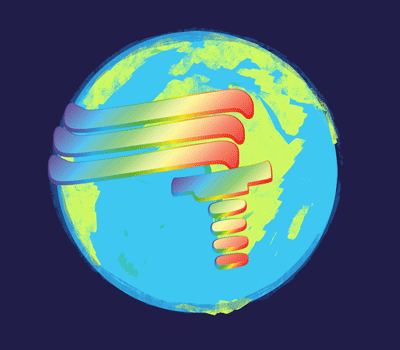About
First Earth Run:
Good Morning America Series
In 1986 at the height of the cold war a torch of peace was passed around the world. The First Earth Run, in partnership with the United Nations Children’s Fund, directly engaged twenty-five million people and 45 heads-of-state in 62 countries. Twenty percent of the planet—a billion people—watched the torch via the media circumnavigate the globe. For 86 days wherever the torch of peace went all wars stopped and the world was united as one.
Watch Good Morning America’s weekly series tell the story of the torch of peace circumnavigating the earth.
First Earth Run: A Catalyst of Hope
by David Gershon
In 1983, I decided to swallow the world whole on my first bite. They say if it doesn’t kill you, it will make you stronger, and I can attest to that. In a literal crucible of fire, the social change framework that I would come to flesh out over the next decades was born, and it was basically a combination of beginner’s luck, timing, a modicum of knowledge about transformation, intuition, and a lot of perseverance that kept me holding on to fan the flames.
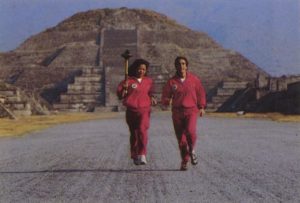 In that year a nuclear war seemed very, very possible. And in November, half of America and the largest audience ever for a TV movie tuned to ABC to watch The Day After, a simulated nuclear holocaust. In this apocalyptic film nightmare, America is destroyed by a nuclear attack launched by the Soviet Union. The movie created an almost palpable shock among Americans as we sat in our living rooms and watched the annihilation of tens of millions of fictional fellow citizens. It was as if Americans had had a collective near-death experience.
In that year a nuclear war seemed very, very possible. And in November, half of America and the largest audience ever for a TV movie tuned to ABC to watch The Day After, a simulated nuclear holocaust. In this apocalyptic film nightmare, America is destroyed by a nuclear attack launched by the Soviet Union. The movie created an almost palpable shock among Americans as we sat in our living rooms and watched the annihilation of tens of millions of fictional fellow citizens. It was as if Americans had had a collective near-death experience.
It was a time when the two most powerful nations on Earth kept their deadliest weapons trained at each other in a doomsday scenario of mutually assured destruction. Children were in despair of ever having a future and the smartest political strategists on the planet could not imagine a way out. The world was enveloped in a profound psychological darkness.
Out of this paralysis a small opening occurred in the American psyche for something innovative to enter. It was into this opening that I entered with a dream: to carry a torch, person to person, country to country, leader to leader, extending a band of light around the world. In my dream, the torch would ignite and unite the people and political leaders of the planet in a shared vision and experience of living together in harmony. And, I hoped it would help to create an opening in the global psyche for something new to be born—what I would come to call a planetary unitive field.
The odds against this coming to pass were immense. Who would help organize an almost impossible dream? Who would be willing to finance such a risky and unprecedented undertaking? What organizations could meet the logistical challenges? What political leaders would put their reputations on the line for such a wildly improbable idea? And if I could somehow defy all these odds and bring this dream into reality, would it really make any difference, given the monolithic forces at play? How much, after all, could a symbolic gesture accomplish?
While I clearly had a lot to learn about the world’s geopolitical complexity, I did have an interesting history. I had organized the Olympic Torch Relay for the 1980 Lake Placid Games and was a seasoned management consultant. I may have been naive, but I couldn’t be completely discounted.
My first recruit, I hoped, would be a sure thing. I had met Gail Straub three years earlier right after organizing the Olympic Torch Relay. She had short blonde hair, a radiant smile, and a contagious joie de vivre. There was no doubt that she was my soul mate and we instantly fell in love. Within a few months we decided to get married and develop a training program that empowered people to envision and manifest their dreams. By the spring of 1983, when this global vision was coming into being, we had been leading this workshop for two years.
I hoped my wife would not only support my dream for the world, but be willing to add her considerable energy, enthusiasm, and expertise to help make it happen. I told her it would certainly be a great adventure. I had had this idea since 1976 when I first tried my hand at large-scale organizing by creating the U.S. Bicentennial Torch Relay. During this relay, a torch was passed nonstop by thirty-two runners for 9,000 miles through America’s forty-eight continental states and then flown to Alaska and Hawaii. The event was created to rekindle the values on which America was founded and which were receding into a post-Vietnam War malaise.
I explained to Gail that this self-funded grassroots initiative had captured the imagination of the country, the media, and the White House. Most important, I discovered that the fire had a mythic power that touched people in a profound way. As the event was winding down at Federal Hall in New York City, the site of George Washington’s inauguration as America’s first president, a thought came to me: Pass the fire, not just around the country, but around the world, uniting people everywhere in the spirit of cooperation. Let the passing of the torch serve as a symbolic way to recognize our common aspiration to live in harmony with one another. I felt this idea was so important that I was willing to dedicate several years of my life to making it happen.
I told Gail that after the Bicentennial Torch Relay I had tried for three years to convince people and institutions to participate in this endeavor. While I was able to create a core organizing team and had the goodwill of many, I had received multiple rejections from funding institutions. Having spent my meager savings, I was running out of options. Suddenly, out of the blue, I was offered an opportunity to organize the 1980 Lake Placid Olympic Torch Relay. I had developed an expertise in a most esoteric craft and essentially had cornered the market. I quickly redirected my team.
It was a remarkable experience. President Jimmy Carter offered us his plane, Air Force One, to transport the flame the 5,000 miles from Olympia, Greece, to Langley Air Force Base in Virginia, from which we would relay it to Lake Placid, New York. The awe of the flight attendants when they viewed the Olympic Flame was perhaps my first real experience of the full extent of the power of this symbol.
I kept the fire in a draft-proof miner’s lamp next to my seat on this surprisingly ordinary-looking plane, and each of the attendants made a point of coming over to look at it. One commented to me: “I have had the pleasure of being host to many important guests on this plane, but the Olympic Flame is the most important.” Their awe was echoed and repeated all along the relay route and once again, I saw the fire’s power to transform and uplift all who gazed on it.
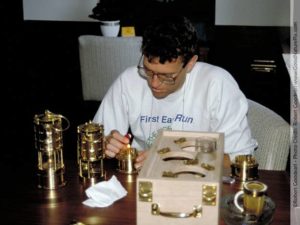
I told Gail that given the credibility I’d gained from organizing the Olympic Torch Relay and the pervasive fear of our planet’s imminent peril, I thought people might now be more willing to embrace this vision. I cautioned her that if we went for this dream, we would need to devote the majority of our time to organizing, which might put our young empowerment training business at risk. We would also have to invest the small inheritance I had recently received from my mother’s death as the start-up capital. Since no one had ever done anything of this global and logistical magnitude before, it would also be very, very hard to do. But if we were able to pull this off, I felt it might just provide enough inspiration to nudge the world in the right direction. Was she up for it? If she wasn’t, I assured her that I certainly would understand.
Her answer was immediate. “If it could make the kind of difference you describe,” she said, “I’m willing to go for it.” After a hug, my next question was, “Do you know anyone who lives in a foreign country?” “Well,” she said, then paused to think, “I know someone who used to live in England; perhaps she could help us find people. ”So began our odyssey to convince the world to participate in this mythic transformative act. What transpired over the next three years demanded more of us than we could ever have imagined.
One by one we began assembling the team. I honed my recruitment pitch to: “Long hours, no pay, and no guarantee of success, but a vision that just might change the world!” It was right out of the classic Japanese movie Seven Samurai, in which a small group of warriors is recruited to save a city under siege by an invading army. Each samurai was accomplished and masterful in his specialty. Each was willing to step out of his life and courageously dedicate himself to a very difficult and highly challenging assignment. It was moving to watch this heroic impulse come alive within a small band of people in the here-and-now.
 Soon we had graduated from convincing individuals to convincing organizations to help us arrange for the passage of the torch through their country. One such organization was the Jaycees, an international association of young leaders dedicated to community service. I was invited to their annual international meeting in Cartegena, Colombia, to present my idea. I made a speech to the entire group hoping for a great reception, but there was no immediate response. How in the world, I wondered, was I was going to find the organizers that I needed?
Soon we had graduated from convincing individuals to convincing organizations to help us arrange for the passage of the torch through their country. One such organization was the Jaycees, an international association of young leaders dedicated to community service. I was invited to their annual international meeting in Cartegena, Colombia, to present my idea. I made a speech to the entire group hoping for a great reception, but there was no immediate response. How in the world, I wondered, was I was going to find the organizers that I needed?
My opportunity came a day later during the Jaycees’ traditional parade through the city. Each contingent of young leaders was lined up behind their national flag and an accompanying placard with their country’s name on it. I realized this could be a bonanza! I darted from placard to placard giving my pitch and setting up meetings for the next few days. In three hours I had identified individuals from eight countries, most of whom signed on to help.
On one trip Gail went to meet with a number of possible organizers in India, Bangladesh, Singapore, Malaysia, and Indonesia. She gave herself ten days to get five organizers. She came back a week and a half later with dysentery, many stories—and the five organizers she sought. The vision was becoming a reality: One country at a time, the world was demonstrating a desire to receive the flame.
Serving as our international director, Gail created a seventy-five-page “how-to” manual that was distributed to each country’s organizing committee. This was to be their primary organizing tool. The only long-distance communications available at that time were cables and phone, both of which were cost prohibitive. The manual explained how to organize the torch relay in their country including financing, publicizing, and creating public ceremonies around it. It also explained a component of the larger initiative that we called “What’s Working in the World.”
With “What’s Working in the World,” we wanted to honor and replicate at the community level what was being created with the torch at a global level: people using their imaginations in the spirit of cooperation to find solutions to important problems. Each community the torch passed through was asked to select the three most successful self-help projects. These self-help projects were to be a celebration of the best of humanity’s ingenuity, and a collection of the most successful community change strategies and practices from around the world. At each community ceremony, the torch would “shed light” on what was working in the world. Our goal was to disseminate these local solutions to other communities so they could become global solutions.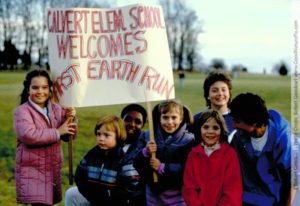
The relay team was a group of runners who served as keepers of the fire and escorts for the torch runners in each country. Our strategy was to divide the world into sixteen geographic regions. The dream, like a beautiful songbird, attracted runners from each of these regions who were willing to add their unique spirit to this epic adventure in the making. They came from Argentina, Australia, Brazil, Canada, China, Costa Rica, Hungary, India, Japan, Kenya, Malaysia, New Zealand, Nigeria, Russia, United Kingdom, and the United States. They were women and men, Hindus, Muslims, Jews and Christians, recreational runners and Olympians. The world’s rich cultural and religious diversity was being assembled and would be placed together for eighty-six days.
The core responsibility of the relay team was to serve as emissaries—welcoming and accompanying each of the thousands of runners from around the world who would carry the torch. They were also charged with assuring the original fire stored in draft-proof miner’s lamps always remained lit. They would face many challenges, from helping runners safely navigate through the massive uncontrolled crowds, to convincing airlines that it was safe to fly with a live flame, to living with others who were so different from themselves.
So how do you transport a multicultural group of people, a live flame, and torches through a different country almost every day? How do you successfully guide people with limited experience in this sort of thing to organize hundreds of community events with millions of people? How do you go about convincing dozens of heads of state to participate? How do you persuade airlines to go against their regulations and allow a live flame on board? How do you get the world’s media to follow this adventure as it circumnavigates the planet? The organizing, logistical, and political challenges were unending. It was like mounting-an-expedition-to-scale-Everest-for-the-first-time meets producing-the-Olympic-Opening-Ceremony!
While these challenges were being confronted, a most daunting one still lay ahead: attracting the several million dollars of financing needed to make all this happen. I needed to provide assurances to the sponsors about our team’s ability to pull off an immensely complex global event that had never been done before. While I had secured seed capital to pay some staff, with six months left to go there was still no major sponsorship. As the seed funding and Gail’s and my financial resources were dwindling, I felt a growing sense of unease. Here we were persuading people all over the world to invest their time and hope, in some cases at the cost of economic hardship, and I might not be able to raise the money to make this happen. Our Japanese organizer, Atsuo Shiga, summed up the situation this way: “How far can one run on an empty stomach?”
For about a year, we had been having discussions with the United Nations Children’s Fund (UNICEF) about a partnership. As our international organization grew and momentum built, their interest was piqued. Ultimately I met with Jim Grant, UNICEF’s visionary leader, who agreed to have his organization become an in-kind sponsor, using the event to celebrate their fortieth anniversary. They would also be a recipient of any funds raised. In return, they would provide office space in their Manhattan headquarters, active support reaching out to heads of state through their international network, and a state-of-the-art communication infrastructure.
In the mid-1980s, this meant an in-house telex machine to receive cable messages; there were no fax machines or e-mail. Our team moved into wonderful new digs overlooking Manhattan’s East River. We were motivated to keep running on an empty stomach.
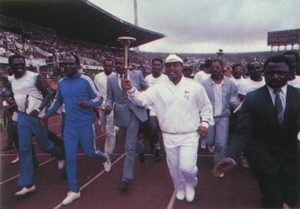 Soon the media caught wind of this initiative. Stories began appearing in the New York Times and on the major TV networks for what was now being called the First Earth Run and the “torch of peace.” One team member, Hal Uplinger, who had helped produce the mega rock concert fundraiser for famine relief in Africa, “Live Aid,” used his contacts to bring ABC Television on as the media sponsor. They committed to providing coverage of the torch’s 12-week passage around the world every Wednesday morning on Good Morning America. This inspired other media across the planet to do the same thing.
Soon the media caught wind of this initiative. Stories began appearing in the New York Times and on the major TV networks for what was now being called the First Earth Run and the “torch of peace.” One team member, Hal Uplinger, who had helped produce the mega rock concert fundraiser for famine relief in Africa, “Live Aid,” used his contacts to bring ABC Television on as the media sponsor. They committed to providing coverage of the torch’s 12-week passage around the world every Wednesday morning on Good Morning America. This inspired other media across the planet to do the same thing.
Then the political leadership support began falling into place, including U.S. President Ronald Reagan, the Soviet Union’s President Mikhail Gorbachev, and China’s President Li Xiannian. As the momentum built, requests started coming from many heads of state asking that the flame go through their country. One of the most meaningful requests came from King Birendra of Nepal. He wished the torch of peace to light an eternal flame he would erect at the pilgrimage birthplace of the Buddha in Lumbini. He said he wanted the millions of Buddhist pilgrims who come to Lumbini to be inspired by this act of peace building. The mythic power of the dream was generating a magic that was captivating all who heard it.
A member of the core team, Brooke Newell, a vice president of the large multinational Chase Manhattan Bank, had begun soliciting her company to sponsor the event from its very inception. As the senior leadership heard of the growing support and momentum that was building, they became more and more interested, concluding that, “this is one of the truly extraordinary activities of our time and is an unparalleled opportunity for our company.” Soon we were negotiating in earnest for a multimillion dollar sponsorship. The only issues were how much they would pay and how they would promote it. Needless to say, this news gave everyone on the organizing team a collective sigh of relief.
Then, one day about three months before the event, Brooke requested a meeting with me. We had been meeting frequently about the negotiations with Chase, but this day Brooke had an ominous look about her. She got right to it. After a hard-headed analysis at the highest levels of the organization, Chase had decided to pull back from sponsorship. They had determined this was too risky an undertaking. So many things could go wrong. They ticked off the potential pitfalls one after the other.
- Without consistently professional crowd control the runners, spectators and team were in danger of bodily harm or even death.
- It was such a high-profile event that it could easily be hijacked by a fringe group for its own political purposes.
- The level of organization was uneven and in any number of countries the event could fall on its face with minimal participation.
- If it was used as a propaganda event by communist dictators it would reflect poorly on the company.
In short, it was just way too risky a venture for them and they were unwilling to go forward.
We were definitely at a moment of truth. Should I thank my amazing team for their efforts and faith in me as a leader, but tell them there just wasn’t enough time to find another sponsor? That we needed to call this off before more expectations were raised? I had invested so many years of work and we were so, so close. I was at a complete loss as to what to do.
I sought support and counsel from my dear wife, Gail, who had been there 110 percent at every step of the journey. She held me and advised me to pray for guidance and sleep on it. I followed her advice and when I woke up the next day, I was clear.
I called our core team of about twenty-five people together in our United Nations offices. They assembled in the only location where everyone could fit—a corridor between our tightly packed offices. Calmly, but with my heart in my throat, I told them: “Chase Manhattan Bank has decided to pull out as a sponsor. We have no other prospects at the moment, as Chase had wished to be the sole sponsor. It would be extremely hard to find a multimillion-dollar sponsorship on this short notice.
“Everyone’s faith and dedication has brought us to this point and now we all need to determine where we stand. I have decided to go forward and I ask each of you to think hard about what you want to do. I will understand if you aren’t willing or able to hang in any longer. After all, most of you have not been paid, and those who have have received only a survival level salary. Our workload is relentless—ten- to twelve-hour days. For every logistical and political challenge we solve, two new ones appear. In spite of this major setback, I will do whatever it takes to find another source of funding.”
The team did not hesitate. They unanimously decided to go forward. They determined they would keep running on an empty stomach.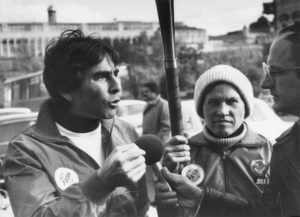
I decided my best chance was to speak to UNICEF’s executive director, Jim Grant, and ask for his financial support. From several communications, I knew Jim had become a real partner. He had told me he was in awe of the response this project was getting from usually reticent political leaders all over the world. He had said that although he was getting some resistance from his country directors, the positive association of people and political leaders around the world toward UNICEF would make their work much easier in the future. He also hoped it would assist their fund-raising efforts both through the event and in the future by the increased visibility. But the bottom line was that he was putting his organization behind this initiative because he believed it was the right thing to do.
I arranged a meeting with Jim the next day to explain what had happened. By the time I arrived, Jim had already heard that Chase had pulled out. When I asked him to consider funding the whole thing, he was ready with an answer. He said, “We will make it happen!” I could not hold back my tears of relief and joy.
This moment marked a phenomenon that became a hallmark: Each time we were faced with a seemingly insurmountable challenge, if we kept the faith, help came. UNICEF became the underwriter, and a better sponsor for a global humanitarian mission of this magnitude could not have been found. We all concluded this dream was blessed with grace.
With funding finally secured, the effort and response from around the world leapt to another level of intensity and scrutiny. I was summoned to meet with senior government leadership in both Moscow and Beijing. High-level officials asked me probing questions seeking to understand how this project had come to be, who was behind it, and what their motivations were. They wanted to know why they should encourage the people of their countries to get involved.
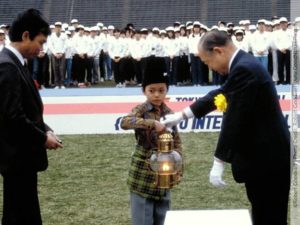
I told them my story and they must have believed me because both countries committed themselves to providing runners for the international team and supporting this event in their countries. In the Soviet Union 60 cities would participate throughout the fifteen Soviet Socialist Republics that made up the country, with huge events planned for Leningrad (now St. Petersburg) and Moscow. In China, large events would be held in Beijing and Shanghai with hundreds of thousands of runners joining a run to the Great Wall. In both countries, the heads of state would honor the flame’s arrival.
Other amazing things were happening. President Daniel Ortega of Nicaragua and his arch enemy, Adolfo Calero, leader of the guerilla group the Contras, would declare a cease-fire for the day and have their children carry the torch together through the capital city of Managua. Jewish and Arab children were going to carry the torch into the Knesset, the Israeli parliament building, in Jerusalem. In Northern Ireland, Catholic and Protestant runners were going to pass the torch from one to another. The president of Iceland wished the torch to be brought to Reykjavik to light a world peace cauldron outside the building where Gorbachev and Reagan were to have their historic first summit meeting. It was as though the geopolitical chessboard were given a second dimension to play on and previously unimagined new moves were being invented.
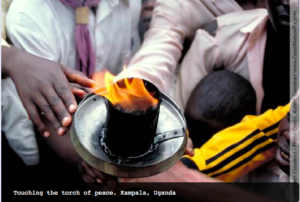 The lighting and launch of the torch of peace on its journey around the world were to take place at the United Nations in New York. The torch was to be lit from a fire created at a sunrise ceremony on the grounds of the United Nations by two Native American elders, Chief Shenandoah of the Iroquois Nation and Grandmother Caroline of the Hopi Nation. Among the native cultures, the Iroquois are the “keepers of the sacred fire.” It is they who are charged among all the native tribes to provide the fire necessary to realize dreams. The Hopi are the “keepers of the dream.” They serve as stewards of the most profound belief and hope on the planet: that human beings can live in harmony with one another and the Earth.
The lighting and launch of the torch of peace on its journey around the world were to take place at the United Nations in New York. The torch was to be lit from a fire created at a sunrise ceremony on the grounds of the United Nations by two Native American elders, Chief Shenandoah of the Iroquois Nation and Grandmother Caroline of the Hopi Nation. Among the native cultures, the Iroquois are the “keepers of the sacred fire.” It is they who are charged among all the native tribes to provide the fire necessary to realize dreams. The Hopi are the “keepers of the dream.” They serve as stewards of the most profound belief and hope on the planet: that human beings can live in harmony with one another and the Earth.
The Hopi people are also keepers of the Hopi Prophecies, reverently handed down from one generation to the next for more than a thousand years. The most important of these prophecies states that when humanity is on the brink of self-destruction, the Hopi must deliver a message at the great hall of mica. If this message is received, the world will begin the “great turning” toward a thousand years of peace. If it is not received, the world will continue its direction and enter into a thousand years of darkness and war. The prophecy states that the Hopi will have four attempts to deliver this message.
The Hopi elders determined that the time described in the prophecy had come, and the great hall of mica was the glass United Nations building on Manhattan’s East Side. For the sake of the world, they diligently sought an audience with the leadership of the United Nations. Their previous requests for an audience with the United Nations had been turned down three times, so this was their final chance. The native cultures were closely tracking what they felt was a momentous opportunity for humanity.
It was a beautiful sunrise in Manhattan. It had rained overnight so the air was pure and the sky was clear. Sunlight was gleaming off the tall rectangular glass United Nations building and surrounding skyscrapers. Political dignitaries, rock stars, and the United Nations secretary general were preparing to participate. It was September 16, 1986, the opening day of the U.N. General Assembly—the international day of peace in the international year of peace.
The evening before, a ceremonial site had been prepared on the U.N. grounds by Chief Shenandoah. There was a little chill in the air that September morning as Chief Shenandoah of the Iroquois Nation rubbed two sticks together, in the ancient way, until a spark was ignited into kindling. The kindling was placed on combustible grasses until a small flame grew into a blazing fire. Many political dignitaries and media were on hand to hear Grandmother Caroline offer the prophecy the Hopi had been stewarding for a millennium.
“Humanity” she said in her soft voice, “is at a crossroads. To continue on this planet, we are being called to achieve a higher level of global community, where we can experience that which unites us. The fire symbolizes the light within that connects us all. As this light goes around the world it will awaken in humanity a deep yearning to live in harmony with each other and the Earth. This will leave a lasting imprint in our memory and initiate the great turning that was prophesized. Learn to interpret the signs. They will be there.”
Her profound message of hope inspired everyone in attendance. Over the next eighty-six days, it would be communicated in one form or another to the twenty-five million people and forty-five heads of state in sixty-two countries who would directly participate in the passage of the fire, and to the billion more who would follow it through the media.
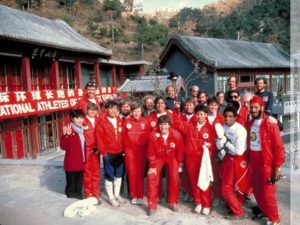 The eighty-six-day journey of the fire around the world was an extraordinary moment on the planet. Wherever the flame traveled, conflict stopped and adversaries cooperated. The anticipated fear of crowds being out of control did not materialize; even when they were wildly enthusiastic, they were also very respectful because of the awe evoked by the fire. There were no injuries, not even a single burn. On more than one occasion, it was raining when the flame arrived, but when the ceremony began, the rain ceased and the sun came out. Airline pilots welcomed the flame onto their planes as a distinguished guest. Inspired art, music, dance, and poetry were created as part of the many ceremonies that greeted the flame, touching people’s spirits and uniting them. Each community proudly shared success stories of how its citizens had cooperated for the common good and achieved something great. And the torch arrived on time for every scheduled ceremony. For eighty-six days, wherever the flame went there was peace and goodwill. These “signs” were noticed by all.
The eighty-six-day journey of the fire around the world was an extraordinary moment on the planet. Wherever the flame traveled, conflict stopped and adversaries cooperated. The anticipated fear of crowds being out of control did not materialize; even when they were wildly enthusiastic, they were also very respectful because of the awe evoked by the fire. There were no injuries, not even a single burn. On more than one occasion, it was raining when the flame arrived, but when the ceremony began, the rain ceased and the sun came out. Airline pilots welcomed the flame onto their planes as a distinguished guest. Inspired art, music, dance, and poetry were created as part of the many ceremonies that greeted the flame, touching people’s spirits and uniting them. Each community proudly shared success stories of how its citizens had cooperated for the common good and achieved something great. And the torch arrived on time for every scheduled ceremony. For eighty-six days, wherever the flame went there was peace and goodwill. These “signs” were noticed by all.
When the flame arrived back at the United Nations in New York, a special session was held in the U.N. General Assembly Hall. Delegates shared story after story of how the people of their countries were uplifted by the fire, united by their common aspirations for a better world, and hopeful now that perhaps it would be possible to create it.
On a personal level I had an experience similar to that described by astronaut Rusty Schweikert, who, on seeing the awesome beauty of the Earth from space, described himself as a “sensing mechanism for humanity.” In this case I felt like humanity’s sensing mechanism on the Earth, experiencing our beauty up close. I experienced the depth of our common humanity and our wondrous diversity. I saw firsthand our ability to rise beyond that which separates us and find ways to cooperate. I witnessed our courage to risk believing, in spite of much evidence to the contrary, that we can create a better world. I also came to believe that yes, anything is possible.
Did the flame’s journey change our world in any demonstrable way? A story will illustrate the mysterious effects of the fire on a few of the mortals playing out one of the great dramas of that time.
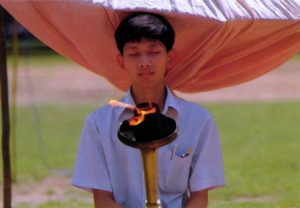 The prime minister of the United Kingdom, Margaret Thatcher, known as the “Iron Lady” because of her toughness, had been reluctant to participate in the First Earth Run, thinking it was all a colossal waste of time. But when the groundswell of political support had grown to include Presidents Mikhail Gorbachev of the Soviet Union, Ronald Reagan of the United States, and Li Xiannian of China, she finally accepted the invitation to take part. Children from each of the major ethnic groups in London were invited to 10 Downing Street for a short candle-lighting ceremony.
The prime minister of the United Kingdom, Margaret Thatcher, known as the “Iron Lady” because of her toughness, had been reluctant to participate in the First Earth Run, thinking it was all a colossal waste of time. But when the groundswell of political support had grown to include Presidents Mikhail Gorbachev of the Soviet Union, Ronald Reagan of the United States, and Li Xiannian of China, she finally accepted the invitation to take part. Children from each of the major ethnic groups in London were invited to 10 Downing Street for a short candle-lighting ceremony.
The flame was carried in by a runner and each child was offered a candle to light from the torch. One by one, as they lit their candles, the children became transfixed, hardly able to move. It was as if in receiving fire from the torch, they had received the collective goodwill of all those people who had transported it and witnessed it in its journey so far. The entire room was transformed. What had been planned as a simple ten-minute ceremony evolved into a two-hour tour through the rich history of this historic building that for 250 years had served as the country’s seat of power, with the prime minister as guide. She told the children of the many important events and decisions that had transpired in those chambers, and impressed on them the need to use their experience with the flame to inspire others in their communities. The powerful presence of the fire had warmed the “Iron Lady,” allowing her momentarily to shed her armor.
A few weeks later she was to be the first Western political leader to meet with President Mikhail Gorbachev of Russia. Her assignment was to determine if he could be trusted and the world could be brought back from the precipice. Knowing that the peace flame had also just passed through Moscow, she shared her candle-lighting experience with one of the meeting organizers. When she arrived in Russia for her historic meeting, she was invited to participate with Gorbachev in a candle-lighting ceremony in the Kremlin similar to the one at Downing Street, with Soviet children representing the country’s many ethnic groups. In this instance they used fire lit from the peace torch that had been maintained in seven-day candles. The fire again had a transforming effect, allowing these two cold warriors to relate to one another in a context of peace and goodwill. The distrust softened in both of them, allowing for intelligence to transcend political posturing. Her communication to the world after their meeting was, “We can do business with him.”
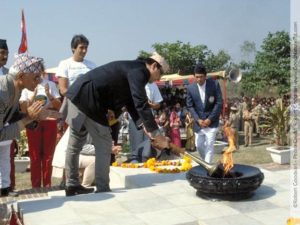 Another example of the alchemical power of the fire and the dream occurred when it penetrated what was then called the Iron Curtain. When the flame arrived in the Soviet Union and Eastern Europe it elicited a palpable emotional response. You could see it in the teary eyes of the tens of thousands of enthusiastic participants who lined the torch relay routes three deep to catch a glimpse of the fire. You could see it in the loving way parents gazed at their children after the flame had passed. And you could most certainly see it in the spontaneous organization of dozens of auxiliary relays that spun off the main route to bring the fire to hundreds more cities throughout these countries.
Another example of the alchemical power of the fire and the dream occurred when it penetrated what was then called the Iron Curtain. When the flame arrived in the Soviet Union and Eastern Europe it elicited a palpable emotional response. You could see it in the teary eyes of the tens of thousands of enthusiastic participants who lined the torch relay routes three deep to catch a glimpse of the fire. You could see it in the loving way parents gazed at their children after the flame had passed. And you could most certainly see it in the spontaneous organization of dozens of auxiliary relays that spun off the main route to bring the fire to hundreds more cities throughout these countries.
It was as if an intoxicating fragrance was wafting through the air. What had been an airtight container was now being permeated with the freshness of innovative new ideas. They were breathing in what free will could achieve. They were breathing in hope and possibility for their lives.
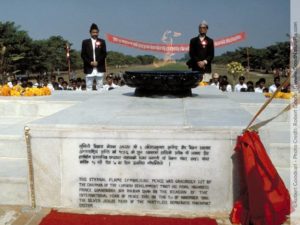 So did the fire and the dream cause a demonstrable change in the world? Thousands of people around the world with whom I have shared the video documenting the story have weighed in with their opinions. Some said it helped catalyze a shift toward a more unitive consciousness on the planet. Some said it created the non sequitur needed to allow the two superpower adversaries to find new footing in their relationship. Some said it empowered the thought leaders in Eastern Europe with a sense of hope and possibility which contributed to the Velvet Revolution and the tearing down of the Berlin Wall. Some said all this would have happened anyway.
So did the fire and the dream cause a demonstrable change in the world? Thousands of people around the world with whom I have shared the video documenting the story have weighed in with their opinions. Some said it helped catalyze a shift toward a more unitive consciousness on the planet. Some said it created the non sequitur needed to allow the two superpower adversaries to find new footing in their relationship. Some said it empowered the thought leaders in Eastern Europe with a sense of hope and possibility which contributed to the Velvet Revolution and the tearing down of the Berlin Wall. Some said all this would have happened anyway.
Ultimately no one will ever really know if the fire’s influence on the hearts and minds of the many around the world translated into these outcomes. What is certain is that a world poised on the precipice of nuclear war somehow miraculously survived, and that people under communist oppression miraculously rose up and with minimal bloodshed threw off their bondage. Were these signs of the great turning foretold by Grandmother Caroline?
And what is the legacy of the fire and the dream? While there are many aspects that affect people, one universally emerges every time I tell this story: the simple fact that this seemingly impossible dream for our world overcame the immense odds against it and actually happened. If this could happen, why couldn’t other acts of seemingly impossible transformation occur as well? The First Earth Run’s legacy is that it fuels people’s imagination and willingness to believe in and create profound transformative change in our world.
Let me close with a story related to me by a Dutch delegate who participated in the negotiations attempting to transform the European Economic Community from a trade organization into the politically and economically integrated European Union. During one of their crucial meetings, its opponents had enumerated the reasons that substantive cooperation could never be achieved.
They said, “We will lose our individuality and unique cultures. We will have to depend on others who may not be economically and politically reliable. There is just no way we will be able to put aside all our past history and animosity. ”When the arguments had been laid out, it was obvious there was no rational counterargument to these fears. A fundamental leap of faith was required that could not be made with logic. A continent was being asked to trust that something better could work in spite of its prior experiences of war and cultural animosity. It was at this moment that a leading advocate for the European Union from the Netherlands reminded everyone about the story of the flame. He stated: “They, too, faced immense resistances that seemed impossible to overcome. Yet they overcame these formidable obstacles and birthed an unprecedented experience of cooperation around the world. Given the opportunity, people were willing to transcend their historic differences and allow themselves to be united by their common desire for a better world. It is now our time to do the same thing.”
The delegates realized that a moment had come to trust without proof and hope that when people from their countries came together they would see that that which united them was stronger than that which had historically separated them. It was clear that the people of Europe could not get to their next level of societal development without an act of trust. The story of the fire contributed to building this safety net of trust. And they took their historic leap into the unknown.
As we face the many monumental global challenges that seem impossible to overcome, it is my hope that the story of the First Earth Run will provide a safety net of trust beneath the dreams of those willing to imagine the impossible. Nelson Mandela, a seasoned veteran of such endeavors, says it well, “It always seems impossible until it’s done.”
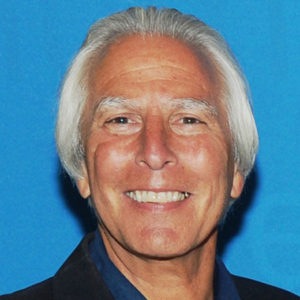
David Gershon
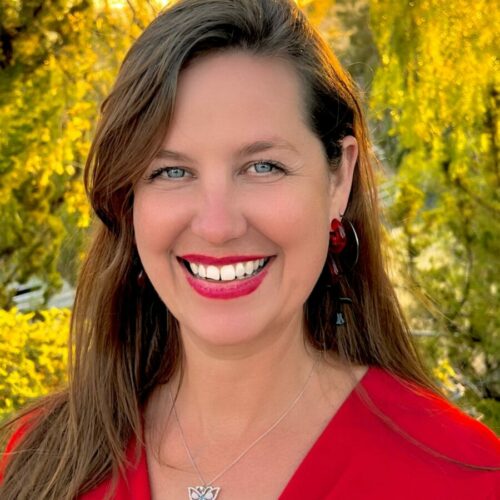
Miranda Clendening
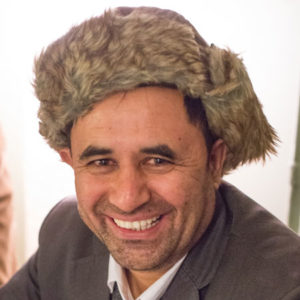
Aziz Royesh
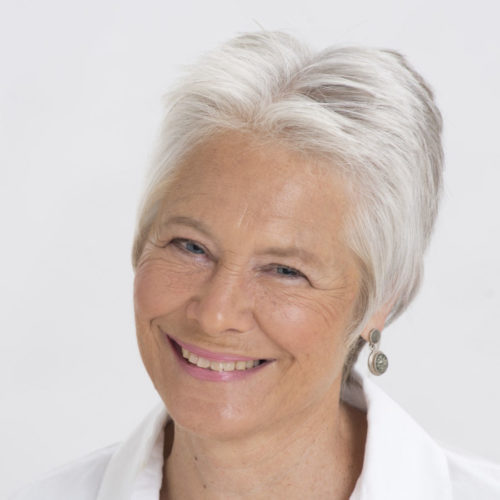
Gail Straub
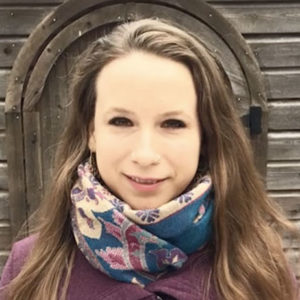
Kristin Hoffman

Carlen Young
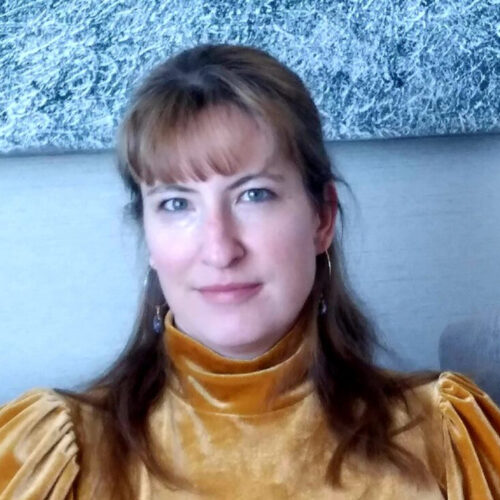
Liz Cox
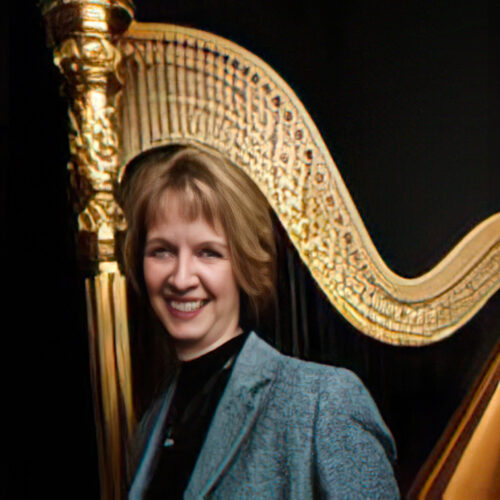
Tamy Briggs

David Gershon
David Gershon, co-founder and CEO of Empowerment Institute has been called “the number one expert on social change.” He applies his visionary leadership and social change expertise to designing second order change solutions for cities, countries and the planet that enable the seemingly impossible to become possible.
In 1986 David organized, at the height of the cold war, the passing of a torch of peace around the world. The First Earth Run, in partnership with the United Nations Children’s Fund directly engaged twenty-five million people and 45 heads-of-state in 62 countries. Over a billion people watched the torch via the media circumnavigate the globe. For 86 days wherever the torch of peace went all wars stopped and the world was united as one. Since then this modern day mythic story embodying humanity’s noblest aspiration for peace on earth and the oneness of humanity has continued to be told all over the world.David is author of twelve books, including the award-winning Social Change 2.0: A Blueprint for Reinventing Our World and the best-selling Empowerment: The Art of Creating Your Life as You Want It.
He directs Empowerment Institute’s Center for Reinventing the Planet which empowers social entrepreneurs from around the world to design and implement second order change social innovations. He has lectured at Harvard, MIT, and Johns Hopkins and served as an advisor to the Clinton White House and the United Nations on empowerment and second order change.
David has dedicated his life to empowering humanity to believe we can create the world of our dreams and designing the strategies and tools to help us make this a reality. He is putting this aspiration and second order knowledge into action through a bold plan to change the world called: “Reinventing the Planet.”
Empowerment Institute:Co-Founder and CEO
Center for Reinventing the Planet:Founder and CEO
Cool Block:Team Leader
Imagine:Team Leader
POE by 2030 Game:Team Leader

Miranda Clendening
Miranda Clendening has brought tens of millions of people together around the world in synchronized meditation and unitive events through her leadership of Unify.org. Her skillset includes non-profit management, technology integration, whole-system community development, and large event facilitation. She will serve as Director of Operations for the Peace on Earth game that includes management of the game platform, game development and the large-scale annual events.
Center for RTP Team:Director of Operations
Cool Block Team:Tech Advisory
Imagine Program Team:Director of Development
POE by 2030 Game Team:Director of Operations

Aziz Royesh
Azizullah Royesh is board member and civic education teacher at Marefat High School (MHS), the educational branch of the Kabul-based nonprofit Marefat Civil Capacity Building Organization. As a top-ten awardee of the Global Teacher Prize 2015, Aziz joined the Empowerment Institute certification program in January 2016. Aziz has studied privately in the field of Farsi literature, the history of Islam, the holy Quran, civic education, and civil rights. He has authored and coauthored a series of textbooks on humanism, human rights, democracy, and interpretation of the Quran that are taught at Marefat High School. Currently he teaches interpretation of the Quran with a humanistic approach at MHS. Aziz Royesh was one of the Yale World Fellows in the class of 2010 and a fellow of Reagan-Fascell at the National Endowment for Democracy (NED) in 2011–2012. He wrote his autobiography as his research paper at NED and published its Farsi version in 2013. The book, titled Let Me Breathe, portrays three decades of change and development in Afghanistan between 1979 and 2012. The acclaimed book The Last Thousand (2016) by Jeffrey Stern tells Aziz’s story and the story of Marefat High School.
Marefat High School and Marefat Civic Capacity Building Organization
Founded in 1994 in the refugee camps of Pakistan, Marefat High School (MHS) is the educational branch of Marefat Civil Capacity Building Organization (MCCBO). Both MHS and MCCBO are tax-exempt nonprofit entities registered in the ministries of education, finance, and economics. The main focus of MCCBO is education, with a democratic and human-rights orientation. The school started its activities in Kabul just after the fall of the Taliban regime in 2001. As of 2016, Marefat High School was home for 3,600 students from kindergarten to twelfth grade. Around 43 percent of the students were female. One of the most successful parts of the Marefat program is adult education, in which adults, mainly women between the ages of fifteen and forty-eight, attend an accelerated learning program. Most of the students have passed their course of studies from first to ninth grade in less than four years. Music, art, Radio Marefat, professional training in audiovideo, electricity, radio, journalism, and a monthly magazine are the extracurricular activities in the school. All programs and activities of MCCO are led and supervised by a board of trustees consisting of influential community members including university professors, businessmen, and civil society activists. www.marefatschool.org

Gail Straub
Gail Straub, cofounder and executive director of the Empowerment Institute, is one of the world’s leading authorities on women’s empowerment. She codirects the Empowerment Institute’s School for Transformative Social Change, which empowers change agents from around the world to design and implement cutting-edge social innovations. As part of this focus, she cofounded IMAGINE: A Global Initiative for the Empowerment of Women to help women heal from violence, build strong lives, and contribute to their community. IMAGINE initiatives are under way throughout Africa, Afghanistan, India, and the Middle East. Gail has been a consultant to many organizations furthering women’s empowerment including the Chinese Women’s Federation, Women for Women International, World Pulse, and the Omega Women’s Leadership Center.
Gail is the author of five books, including, with her husband, David Gershon, the best-selling Empowerment: The Art of Creating Your Life As You Want It; the critically acclaimed The Rhythm of Compassion: Caring for Self, Connecting with Society; and the award-winning feminist memoir Returning to My Mother’s House: Taking Back the Wisdom of the Feminine. She is also a contributor to the anthology Enlightened Power: How Women Are Transforming the Practice of Leadership.
Taking her empowerment work global early in her career, Gail served as the international director for the First Earth Run, a historic planetwide initiative cosponsored by the United Nations Children’s Fund (UNICEF) and ABC Television in 1986, during the height of the cold war. As a torch of peace was passed around the world, 25 million people in sixty-two countries participated and the relay garnered recognition from forty-five heads of state. The event raised millions of dollars for UNICEF that was distributed to the neediest children in the world.
Gail has served in the Peace Corps in West Africa and on many boards including Omega Institute and the Russian American Initiative.
Empowerment Institute Team:Co-Founder, Executive Director
Imagine Program Team:Co-Founder, Executive Director

Kristin Hoffman
Kristin Hoffmanis a singer-songwriter-musician and activist. Her music has been heard on major record labels, film and television, and she has performed throughout the world. A strong advocate for peace and the environment, Kristin has appeared internationally at environmental concerts and conventions. Kristin will be developing the sound track for the Peace on Earth Game and serving as music director for our annual celebratory events.
Kristin Hoffmann is a Julliard trained singer-songwriter-musician with extraordinary artistic range. Her music has been heard on major record labels, film and television, and she has performed throughout the world, collaborating with musical luminaries on projects ranging from individual albums to grand symphonic productions.
A strong advocate for peace and ocean conservation, Kristin has appeared internationally at environmental concerts and conventions, TEDx San Francisco, The Emoto Peace Project concert in Tokyo, and with The Royal Philharmonic Orchestra in London. In August, 2016, the symphonic version of her “Song for the Ocean” was performed at Sydney Opera House by a choir of 800 Australian children. In 2011 she became the singer for Bella Gaia, a multimedia theater experience created in conjunction with NASA. Kristin writes a monthly song and blog for Gandhi’s BE Magazine, addressing worldly issues through the vehicle of music.
Kristin’s songs reflect her personal luminosity, her warmth, and her talent for bringing out music’s healing power.
Center for RTP Team:Singer, Music Producer

Carlen Young
Carlen is passionate about community psychology, empowerment, and human-computer interaction. He applies these passions to increase personal agency and planetary well-being through designing social impact web and app platforms.
As the co-founder of DiviniTree Yoga, and a psychology research associate with the University of California, Santa Cruz, Carlen spent the last decade exploring community building and the process of empowerment. He brings this experience and knowledge as the platform architect and technology wizard of the Peace on Earth game and the other Reinventing the Planet web platforms.
Center for RTP Team:CTO / Creative Director
POE by 2030 Game Team:Platform Design, Partner Outreach

Liz Cox
Liz Cox is the Co-Director of Partnerships with the Empowerment Institute. Her natural enthusiasm for humanity’s collective potential drives her creative process. Liz has a collaborative intuition, making her a perfect intermediary in partnership consultations and catalyzing in terms of germinating a revitalized Earth. Her administrative skills, partnered with her joy for networking, allows her to serve as support to the Empowerment Institute’s Executive Direction and Operations Coordination. As a planner and producer, Liz has curated multi-day immersive events and retreats throughout western North Carolina since 2013. She has orchestrated musical and mystical performances, scientific conferences, and healing meditations in over 40 US states. Liz likes to refer to herself as a liaison for humanitarian evolution and is 110% committed to its mission.
Musician
Tamy Briggs
Tami Briggs is a therapeutic harpist and peace activist; she started playing the harp about the time she attended the Empowerment Workshop in St. Paul, Minnesota. For the Peace 2030 meditations, she customized the music with the intention to play the harp at the frequency/vibration carrying each of the seven Unitive Strategies out to humanity and the planet for peace. Her website is www.MusicalReflections.com.
Why Play
- To create peace on earth by 2030.
- To be part of a global movement of committed people changing the world.
- To meet and interact with amazing people from across the planet.
- To learn about the challenges and transformational opportunities to evolve the planet’s many cultures and achieve collective impact at scale.
- To evolve your skills as a change maker.
- To further your personal growth.
- To have fun and exciting adventures in changing the world.
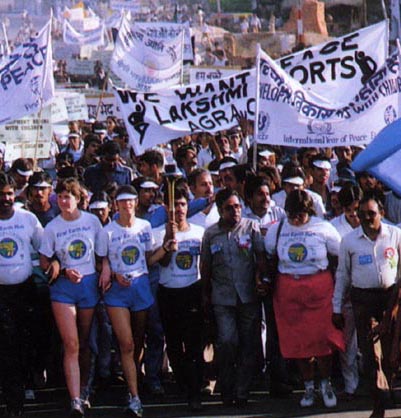
How The Game Works
- Back Story: The game is based upon the 1986 First Earth Run and the 86 days in which wherever the Torch of Peace went all wars stopped and the world was united as one. At the heart of the First Earth Run success were 7 strategies. These strategies have been created into 7 actions that are the foundation of the game.
- The Seven Actions: The actions are offered as quests each of which develops a different skillset that contributes to peace on earth. A player is awarded a virtual bronze, silver and gold Peace Medal along with Peace on Earth (POE) Points based on their level of accomplishment.
- Meetings: A team of 5 to 8 people meet locally or virtually eight times with each meeting being 2 hours. One person serves as team leader and the other team members take turns facilitating the meetings using detailed scripts.
- DreamKeeper: A player becomes a DreamKeeper – one who believes peace on earth by 2030 is possible and is committed to making it a reality – upon successful completion of all 7 actions. Forty million DreamKeepers tips humanity toward peace on earth. Becoming a DreamKeeper is the equivalent to being initiated into the Jedi Knight or Knights Templar orders. As part of this opportunity DreamKeepers are invited to join Legions of Light to further the game.
- POE Zone: A key goal of the game is to establish POE Zones in every place on Earth. When a player or team complete all seven actions, they have the opportunity to create a POE Zone where they live. Each POE Zone will be recognized with bronze, silver and gold peace medals based on participation levels. We hope these POE Zones – places where the peace on earth actions are practiced – become sacred pilgrimage sites people visit to partake in the benevolence generated.
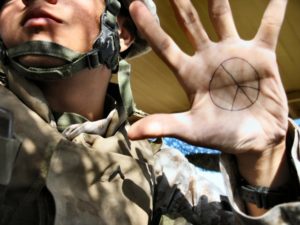
- Create a compelling personal story for why you are playing the Peace on Earth by 2030 game.
- Visualize peace on earth in 2030 as a reality and how your actions helped create it. The more you visualize it, the deeper your belief becomes. The deeper your belief becomes, the quicker this reality can manifest.
- Develop the courage of your conviction so you can empower your peers to step up to this daring goal for humanity.
- Create an enrollment goal, plan and timeline for reaching out to your network. The goal is to invite people in your network to serve as Team Leaders and form a Peace on Earth by 2030 team.
Note: In the pilot version of this action you are asking people to start a POE team when the game is formally rolled out in September 2020 versus right now. This will build momentum for the launch and generate buzz for the game and powerful vision of possibility it is offering the world at a moment in time when it really needs it.
- Make it happen!
- Connect with your team mates to exchange inspiration and best practices.
- Record your successes, learning and best practices in taking this action. Please share them with us via a one to three-minute video so we can spread them throughout the POE 2030 network. You will receive 50 POE Points for sharing this video with us.
Seven Actions to Create Peace on Earth
Each action is divided into the following sections: An introduction by David Gershon that provides the First Earth Run context and builds a case for why to take the action. This is followed by the why act, how to act, gameplay, success strategy, and tips. These are the seven actions and their purpose.
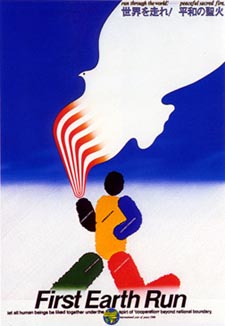
Action 1 – A Critical Mass of DreamKeepers: Inviting Your Network to Play
Purpose: To be the vanguard of human beings on the planet willing to hold the belief that peace on earth by 2030 is possible and are committed to making this a reality.
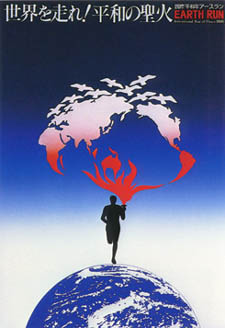
Action 2 – Befriending the Other: Bridging our Differences
Purpose: To create harmony in the world and more wholeness in yourself by befriending those who are different from you.
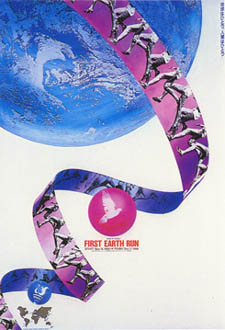
Action 3 – And a Child Shall Lead the Way: Empowering the Next Generation to Befriend the Other
Purpose: To empower a young person to create harmony in the world and more wholeness in them self by befriending those who are different from them.
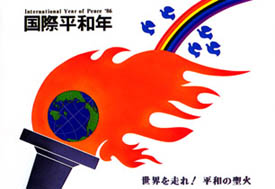
Action 4 – The Unitive Impulse: Celebrating Our Shared Humanity
Purpose: To experience and celebrate that which we have in common with other human beings and cultures.
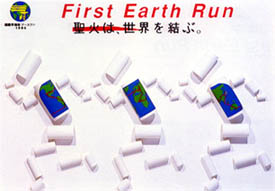
Action 5 – Better Together: Cooperation for the Common Good
Purpose: To experience the collective benefit of working with others around a shared purpose in service to the larger good.
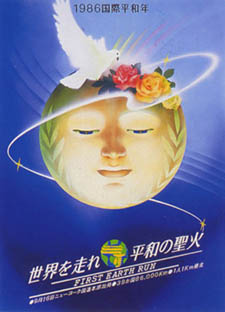
Action 6 – Blessed Are the Peace Makers: Supporting Those Creating Peace on Earth
Purpose: To support organizations that model the Peace on Earth by 2030 values of befriending the other, honoring the oneness of humanity and cooperation for the common good.

Action 7 – The World Heart: Praying for and Visualizing Peace on Earth
Purpose: To pray for and visualize peace within yourself and the world; and for peace on earth by 2030.
What types of people are best to recruit as team leaders?
- People who wish to believe peace on earth is possible.
- People who wish to feel hopeful for the future.
- People who wish to change the world and belief it is possible.
- People who already working on creating a better world through helping people change.
- People who want to empower people to change.
- People who trust you and will listen to your invitation.
- People who wish to be on the vanguard of the new.
- People who want to be part of changing the conversations of our world from polarity and cynicism to unity and positivity.
- People who want to be part of the next cool thing to make an impact in the world.
- People who like to think of themselves as a DreamKeeper.
- People who have organizations that might benefit from making this game available to their members.
Are there here any video resources to use for this action?
I love this video as it opens up the space for believing in the possible and how ready people are to take action.
The First Earth Run video is a catalyst of hope and inspires people to believe peace on earth is a real possibility if we can ignite peoples imagination and provide them the tools to take action.
What did you learn from taking this action?
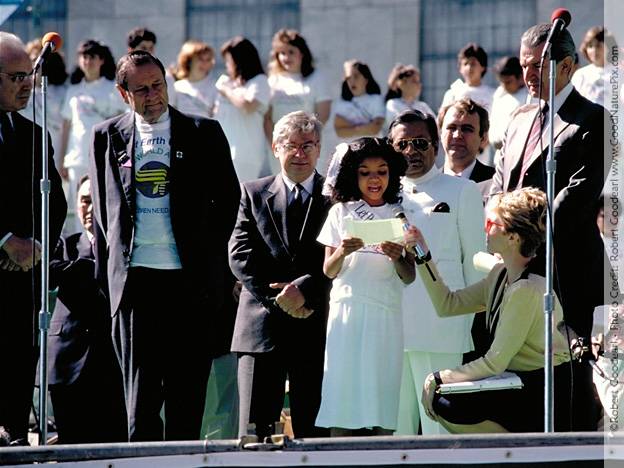
Introduction
In 1986 at the height of the cold war a torch of peace was passed around the world. The First Earth Run, in partnership with the United Nations Children’s Fund, directly engaged twenty-five million people and 45 heads-of-state in 62 countries. Twenty percent of the planet—a billion people—watched the torch via the media circumnavigate the globe. For 86 days wherever the torch of peace went all wars stopped and the world was united as one.
The torch of peace was lit in a sunrise ceremony on the grounds of the United Nations on September 16, 1986—the international day of peace in the international year of peace. At that ceremony Grandmother Caroline, a keeper of the Hopi Prophecy, shared these prophetic words: the torch of peace launched from this Great Hall of Mica marks the great turning toward 1,000 years of peace. Pay attention to the signs as they will help guide its journey. Since then this modern-day mythic story embodying humanity’s noblest aspiration for peace on earth has continued to be told all over the world.
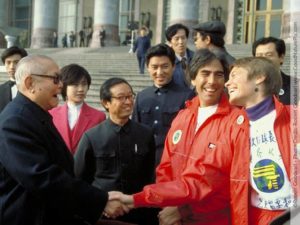
Now the signs indicate it is time for the torch of peace to be reignited to fulfill its prophetic mission of creating peace on earth. The planet’s wisdom keepers tell us that when ½ of 1% of humanity wholeheartedly believe peace on earth is possible (40 million people), there will be enough coherence of thought and emotion to shift our collective consciousness to make this a reality. But to create this future we need to believe it is possible. What we believe becomes our reality for better or worse. To shift humanity’s belief system requires a new story and the means to attain it.
That new story is called Peace on Earth by 2030. To achieve this, we are building a 40-million-person movement of DreamKeepers empowered with the seven actions that enabled the First Earth Run to unite the world and create peace on earth over its 86-day journey. These seven actions are designed as a global game that will take place between 2020 and 2030.
On September 21, 2020—the international day of peace and 34 years after the torch of peace circumnavigated the globe—we will launch the 7 actions to create peace on earth by 2030 and the Second Earth Run! In this case a 12-month virtual Earth Run that will take place annually over the decade in which people play the game locally and showcase their results globally. With the reach of the internet we don’t need to literally run around the world to inspire and empower people with this vision of hope and possibility.
The goal of the annual Earth Runs is for teams playing the game to create Peace on Earth (POE) Zones in their communities where these seven actions are practiced. The POE Zones established each year will be honored through a global musical celebration of our ever-increasing achievement of peace on earth and good will to all. With the torch held high we will experience the world we most want in our hearts coming into existence and witness the dawning of a new future for humankind!
A Call to Play
At this critical time when we are becoming more and more divided, this game serves as deep medicine to heal that which separates us. The First Earth Run’s seemingly impossible achievement of peace on earth for 86 days became possible because the world was so divided it needed light to remind us of the oneness of our humanity. It is time to build on this base camp achievement for humanity and make the full ascent to peace on earth in one decade!
We know in our soul as a species that we are primed for deep transformation to occur at this time. There are so many people of good will connected through social networks across the planet that with the right spark we can ignite a global fire that empowers humanity to fulfill its deepest dream. These seven actions for creating peace on earth have proven they can ignite such a global fire.
Is peace on earth humanity’s destiny? It can be if enough of us say: “I am willing to be one of the DreamKeepers and carry the torch to make it a reality.” We invite you to be one of the planet’s DreamKeepers and a sacred torch bearer for our future as a species!
May those of us living in the 21st century be known in the history of our planet as the heroic generation that brought goodwill to all of humanity and established peace on our beautiful Earth!
